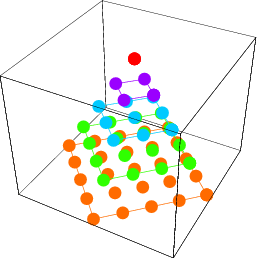

تاريخ الرياضيات

الاعداد و نظريتها

تاريخ التحليل

تار يخ الجبر

الهندسة و التبلوجي


الرياضيات في الحضارات المختلفة

العربية

اليونانية

البابلية

الصينية

المايا

المصرية

الهندية


الرياضيات المتقطعة

المنطق

اسس الرياضيات

فلسفة الرياضيات

مواضيع عامة في المنطق


الجبر

الجبر الخطي

الجبر المجرد

الجبر البولياني

مواضيع عامة في الجبر

الضبابية

نظرية المجموعات

نظرية الزمر

نظرية الحلقات والحقول

نظرية الاعداد

نظرية الفئات

حساب المتجهات

المتتاليات-المتسلسلات

المصفوفات و نظريتها

المثلثات


الهندسة

الهندسة المستوية

الهندسة غير المستوية

مواضيع عامة في الهندسة

التفاضل و التكامل


المعادلات التفاضلية و التكاملية

معادلات تفاضلية

معادلات تكاملية

مواضيع عامة في المعادلات


التحليل

التحليل العددي

التحليل العقدي

التحليل الدالي

مواضيع عامة في التحليل

التحليل الحقيقي

التبلوجيا

نظرية الالعاب

الاحتمالات و الاحصاء

نظرية التحكم

بحوث العمليات

نظرية الكم

الشفرات

الرياضيات التطبيقية

نظريات ومبرهنات


علماء الرياضيات

500AD

500-1499

1000to1499

1500to1599

1600to1649

1650to1699

1700to1749

1750to1779

1780to1799

1800to1819

1820to1829

1830to1839

1840to1849

1850to1859

1860to1864

1865to1869

1870to1874

1875to1879

1880to1884

1885to1889

1890to1894

1895to1899

1900to1904

1905to1909

1910to1914

1915to1919

1920to1924

1925to1929

1930to1939

1940to the present

علماء الرياضيات

الرياضيات في العلوم الاخرى

بحوث و اطاريح جامعية

هل تعلم

طرائق التدريس

الرياضيات العامة

نظرية البيان
Square Pyramidal Number
المؤلف:
Anglin, W. S.
المصدر:
"The Square Pyramid Puzzle." Amer. Math. Monthly 97
الجزء والصفحة:
...
24-12-2020
3524
Square Pyramidal Number

A figurate number of the form
 |
(1) |
corresponding to a configuration of points which form a square pyramid, is called a square pyramidal number (or sometimes, simply a pyramidal number). The first few are 1, 5, 14, 30, 55, 91, 140, 204, ... (OEIS A000330). The generating function for square pyramidal numbers is
 |
(2) |
The square pyramidal numbers are sums of consecutive pairs of tetrahedral numbers and satisfy
 |
(3) |
where  is the
is the  th triangular number.
th triangular number.
The only numbers which are simultaneously square  and square pyramidal
and square pyramidal  (the cannonball problem) are
(the cannonball problem) are  and
and  , corresponding to
, corresponding to  and
and  (Ball and Coxeter 1987, p. 59; Ogilvy 1988; Dickson 2005, p. 25), as conjectured by Lucas (1875), partially proved by Moret-Blanc (1876) and Lucas (1877), and proved by Watson (1918). The problem requires solving the Diophantine equation
(Ball and Coxeter 1987, p. 59; Ogilvy 1988; Dickson 2005, p. 25), as conjectured by Lucas (1875), partially proved by Moret-Blanc (1876) and Lucas (1877), and proved by Watson (1918). The problem requires solving the Diophantine equation
 |
(4) |
(Guy 1994, p. 147). Watson (1918) gave an almost elementary proof, disposing of most cases by elementary means, but resorting to the use of elliptic functions for one pesky case. Entirely elementary proofs have been given by Ma (1985) and Anglin (1990).
Numbers which are simultaneously triangular  and square pyramidal
and square pyramidal  satisfy the Diophantine equation
satisfy the Diophantine equation
 |
(5) |
Completing the square gives
 |
(6) |
 |
(7) |
 |
(8) |
The only solutions are  , (0, 0), (1, 1), (5, 10), (6, 13), and (85, 645) (Guy 1994, p. 147), corresponding to the nontrivial triangular square pyramidal numbers 1, 55, 91, 208335.
, (0, 0), (1, 1), (5, 10), (6, 13), and (85, 645) (Guy 1994, p. 147), corresponding to the nontrivial triangular square pyramidal numbers 1, 55, 91, 208335.
Numbers which are simultaneously tetrahedral  and square pyramidal
and square pyramidal  satisfy the Diophantine equation
satisfy the Diophantine equation
 |
(9) |
Beukers (1988) has studied the problem of finding solutions via integral points on an elliptic curve and found that the only solution is the trivial  .
.
REFERENCES:
Anglin, W. S. "The Square Pyramid Puzzle." Amer. Math. Monthly 97, 120-124, 1990.
Anglin, W. S. The Queen of Mathematics: An Introduction to Number Theory. Dordrecht, Netherlands: Kluwer, 1995.
Baker, A. and Davenport, H. "The Equations  and
and  ." Quart J. Math. Ser. 2 20, 129-137, 1969.
." Quart J. Math. Ser. 2 20, 129-137, 1969.
Ball, W. W. R. and Coxeter, H. S. M. Mathematical Recreations and Essays, 13th ed. New York: Dover, p. 59, 1987.
Beukers, F. "On Oranges and Integral Points on Certain Plane Cubic Curves." Nieuw Arch. Wisk. 6, 203-210, 1988.
Conway, J. H. and Guy, R. K. The Book of Numbers. New York: Springer-Verlag, pp. 47-50, 1996.
Dickson, L. E. History of the Theory of Numbers, Vol. 2: Diophantine Analysis. New York: Dover, 2005.
Guy, R. K. "Figurate Numbers." §D3 in Unsolved Problems in Number Theory, 2nd ed. New York: Springer-Verlag, pp. 147-150, 1994.
Kanagasabapathy, P. and Ponnudurai, T. "The Simultaneous Diophantine Equations  and
and  ." Quart. J. Math. Ser. 2 26, 275-278, 1975.
." Quart. J. Math. Ser. 2 26, 275-278, 1975.
Ljunggren, W. "New Solution of a Problem Posed by E. Lucas." Nordisk Mat. Tidskrift 34, 65-72, 1952.
Lucas, É. Question 1180. Nouv. Ann. Math. Ser. 2 14, 336, 1875.
Lucas, É. Solution de Question 1180. Nouv. Ann. Math. Ser. 2 15, 429-432, 1877.
Ma, D. G. "An Elementary Proof of the Solution to the Diophantine Equation  ." Sichuan Daxue Xuebao 4, 107-116, 1985.
." Sichuan Daxue Xuebao 4, 107-116, 1985.
Moret-Blanc, M. Question 1180. Nouv. Ann. Math. Ser. 2 15, 46-48, 1876.
Ogilvy, C. S. and Anderson, J. T. Excursions in Number Theory. New York: Dover, pp. 77 and 152, 1988.
Sloane, N. J. A. Sequence A000330/M3844 in "The On-Line Encyclopedia of Integer Sequences."
Watson, G. N. "The Problem of the Square Pyramid." Messenger. Math. 48, 1-22, 1918.
Wolf, T. "The  Puzzle." https://home.tiscalinet.ch/t_wolf/tw/misc/squares.html.
Puzzle." https://home.tiscalinet.ch/t_wolf/tw/misc/squares.html.
 الاكثر قراءة في نظرية الاعداد
الاكثر قراءة في نظرية الاعداد
 اخر الاخبار
اخر الاخبار
اخبار العتبة العباسية المقدسة

الآخبار الصحية















 قسم الشؤون الفكرية يصدر كتاباً يوثق تاريخ السدانة في العتبة العباسية المقدسة
قسم الشؤون الفكرية يصدر كتاباً يوثق تاريخ السدانة في العتبة العباسية المقدسة "المهمة".. إصدار قصصي يوثّق القصص الفائزة في مسابقة فتوى الدفاع المقدسة للقصة القصيرة
"المهمة".. إصدار قصصي يوثّق القصص الفائزة في مسابقة فتوى الدفاع المقدسة للقصة القصيرة (نوافذ).. إصدار أدبي يوثق القصص الفائزة في مسابقة الإمام العسكري (عليه السلام)
(نوافذ).. إصدار أدبي يوثق القصص الفائزة في مسابقة الإمام العسكري (عليه السلام)


















